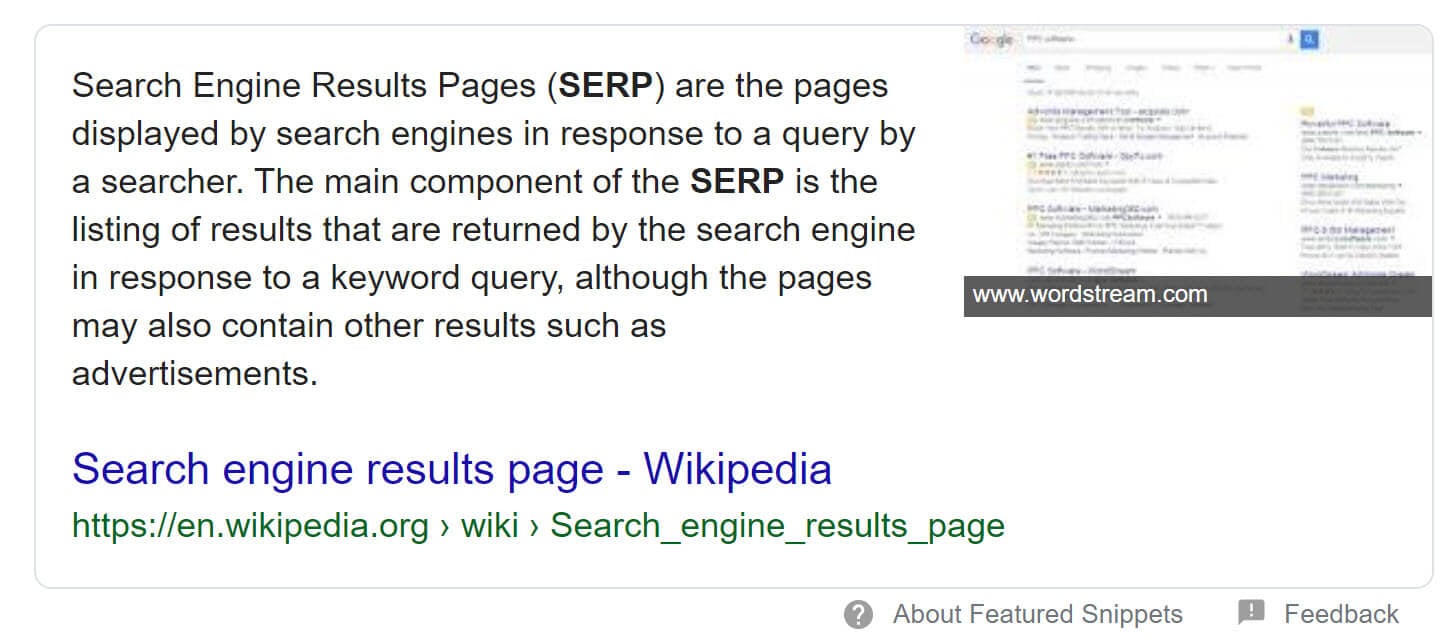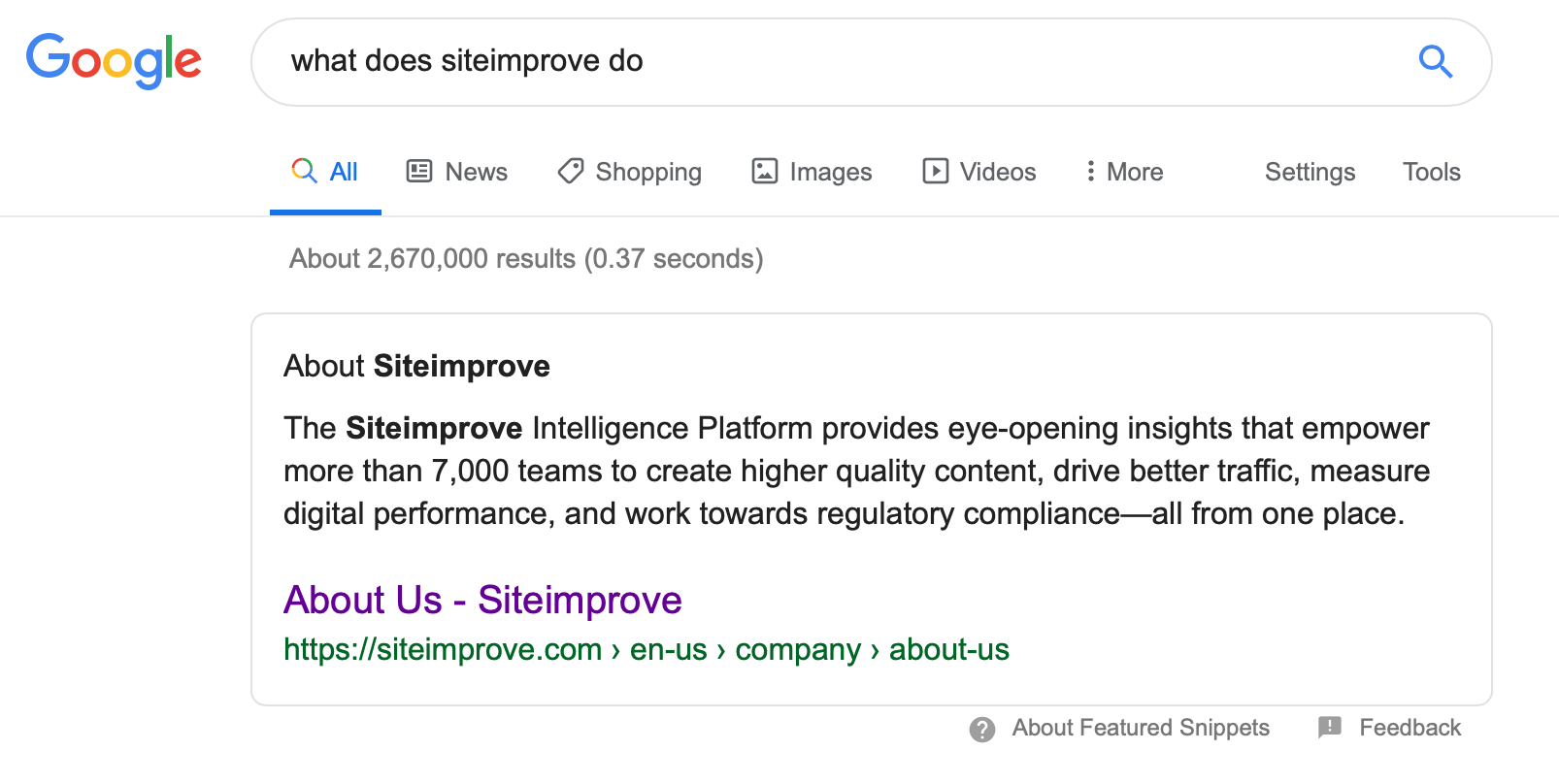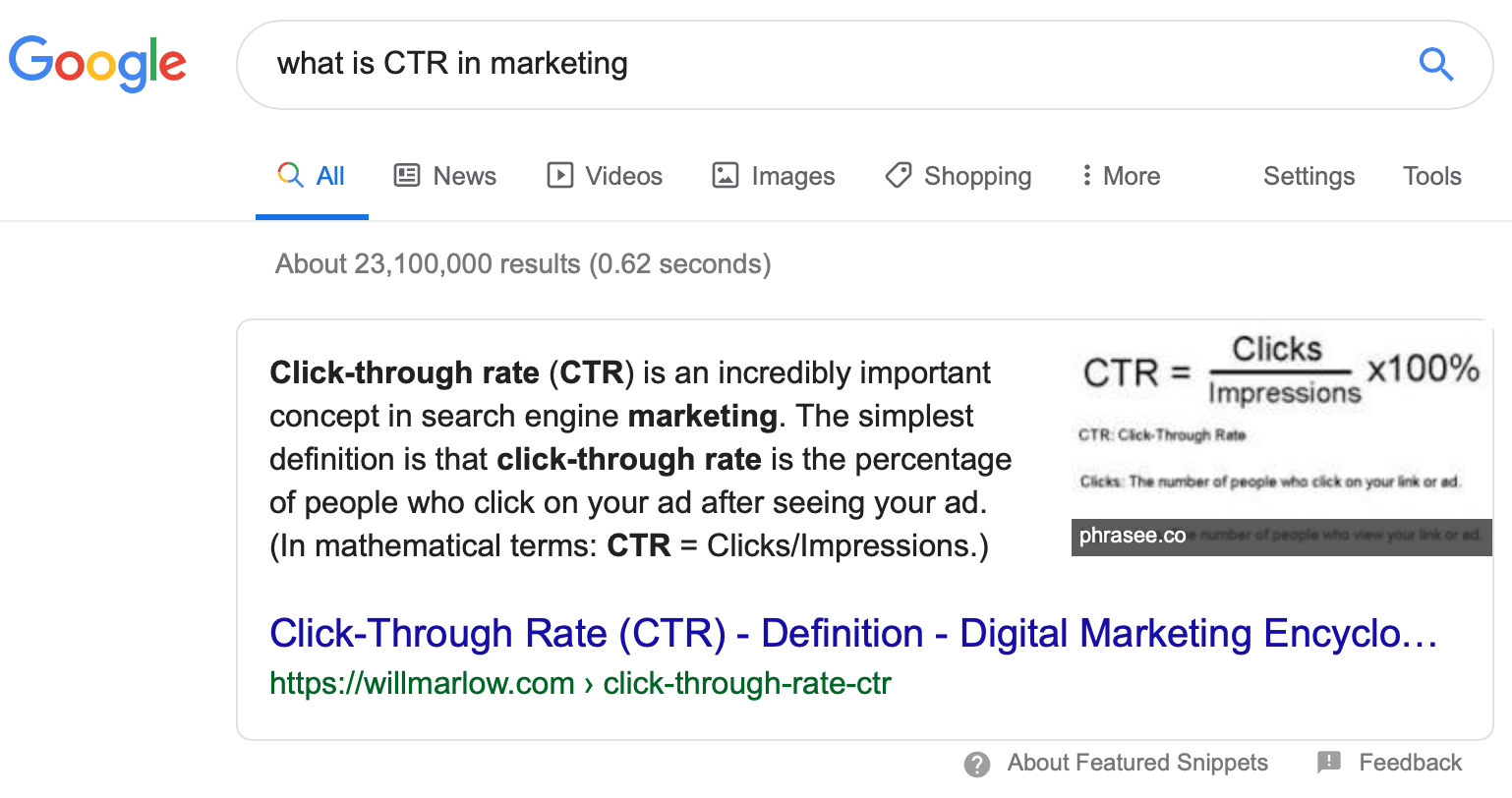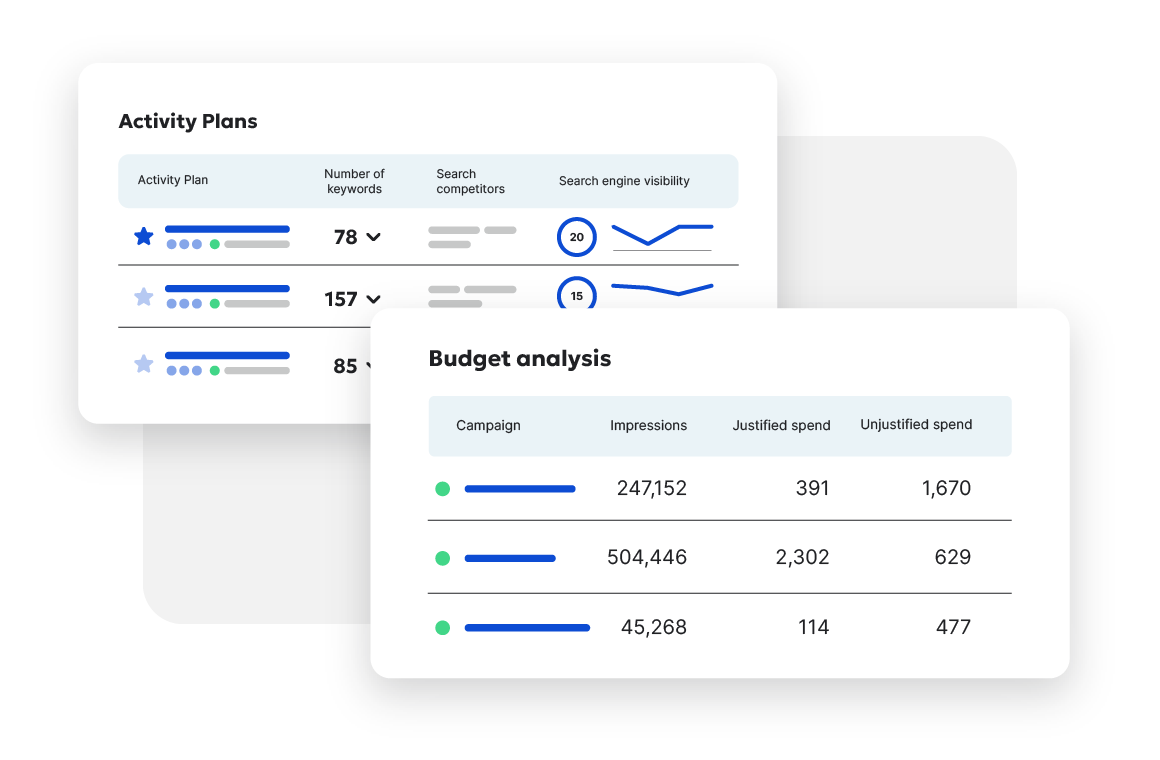Ranking number one in Google SERPs has a major impact on your organic traffic: around 30% of traffic for any given search goes to the result in position number one. And organic results still receive the most clicks and are more trusted by users (one study suggests organic results receive 94% of clicks and paid results only 6%).
But ranking number one no longer takes the lion’s share of clicks. Now, it’s “position zero,” or featured snippets.
Featured snippets have been around since 2013 when they were known as “Quick Answers.” For the most part, they were boxes of information from Google’s own database that directly answered a particular search query, like this:

But (surprise!) they’ve evolved a lot since then. In 2016, Google officially announced that they were calling them “featured snippets,” and the search engine giant has tweaked and refined them a number of times since then.
According to Moz, being featured in position zero means getting additional brand exposure in search results.
Here are two studies confirming the claim:
- Ben Goodsell reports that the click-through rate (CTR) on a featured page increased from 2% to 8% once it's placed in an answer box, with revenue from organic traffic increasing by 677%.
- Eric Enge highlights a 20–30% increase in traffic for ConfluentForms.com while they held the featured snippet for the query.
But before we dive more into the importance of featured snippets, let’s cover the basics first.
What is a featured snippet?
A featured snippet is a direct answer to a particular search query, and it appears in “position zero,” above the organic search results on the SERP. It can come in several formats, including paragraphs, bulleted lists, numbered lists, images, charts, tables, and knowledge graphs.
It looks like this:

And featured snippets are becoming more common. 23% of all search terms results pages now feature a featured snippet, up 165% since 2016.
Why should I care about featured snippets?
As you can see, featured snippets take up a huge chunk of SERP real estate, right at the top of the page. For SEOs trying to improve their Google rankings, they are a golden opportunity. One analysis found that about 70% of featured snippets came from the top three ranking organic search results, but 30% came from lower ranking pages.
This means that even lower-ranking websites and pages have a shot at increasing their visibility using featured snippets. But how do you do it? Let’s take a look.
How to get a featured snippet: Six steps
As with most things Google, there’s no sure-fire way to ensure that you get the results you’re after. That said, there are definitely things you can do to encourage Google to use your content in a featured snippet.
Here are six steps you can take to move towards featured snippet territory:
- Choose a target query that relates to your industry and is frequently asked by Google users. Try using a tool like Google Trends to discover what users are searching for.
- Choose your page to modify based on its current Google ranking for that query and engagement.
- Create a comprehensive list of related questions that your customers might ask.
- Create “snippable” short form content with a heading that directly answers your target query.
- Add to your content. Be sure that it answers all of the “related questions” you came up with in Step 3.
- Format your “snippable” content in a way that makes it easy for Google to find and snip.
Let’s take a closer look at the six steps for getting Google to snip your content.
1. Choose a relevant query with high search volume
It’s important to choose a query that is highly relevant to your business or organization and the customers that you serve. What questions are your customers asking? And more importantly, which questions can your business answer?
If your business provides content marketing services to other companies, you might try to think like someone who is new to SEO and marketing. They’re reading blog posts and articles that use terms they are unfamiliar with, and they probably have to Google their definitions.
So start with a short Google query for one of these terms. Perhaps try “What is CTR in marketing?”

Next, take a look at the “People also ask” questions underneath.

Now it’s time to do a little research. Which of these questions is likely to be asked the most by your customers? Here are a few ways to find out:
Locate featured snippet opportunities
To find out which featured snippets your competitors are ranking for, you can use Google, or a purpose-built tool. Take note of your targets: you will need to create content that’s better optimized for featured snippets than what is currently ranking in position zero.

Identify content ideas on Quora, Answer the Public, and Reddit
All of these sites contain questions that real people need answers to, so use them. Search Quora, Answer the Public, or Reddit for the topic you want to write about, and you’ll find questions that people have already asked about that topic.
2. Choose your target page
Note: In January 2020 Google announced that web pages in a featured snippet will no longer repeat in page one of Google's organic search results. If your web page is selected as a featured snippet, Google's de-duplication policy will push it down to page two, or possibly lower, in organic search.
It’s possible to make it to position zero even if your page or site doesn’t rank in the top three organic search results. However, your snippet has a better chance of getting featured if your page ranks in at least the top five.
Therefore, if you plan to modify an existing page on your site, choose one that already ranks at number five or higher. If you choose to create a new page, you’ll need to invest time into improving the SEO of that page.
Only Google knows exactly what goes into their algorithm for choosing featured snippets. However, engagement may have something to do with it. One analysis found that sites with very high CTR and time on site averages were much more likely to be featured, even if their page rank was low.
So, when you’re scouring your site for pages that are ripe for snipping, be sure to choose pages that:
- Rank in the top five organic search results.
- Have great engagement numbers.
3. Create a comprehensive list of related questions
Remember that list of questions you made in step one? Here’s where you add to it. Create the most comprehensive list you can and include many related questions that your customers might ask.
4. Create “snippable” content that directly answers your target query
Now it’s time to answer your target query in a clear, succinct, and informative way. Try to follow these guidelines:
- Think about your answer from a customer’s point of view. What information are they looking for?
- Ensure your answer is clear, direct and easy to understand.
- Don’t forget voice search results, where short, concise answers are optimal.
- Find a spot in your web page where your answer can fit organically. Remember, this answer doesn’t have to make up the entire article. For example, if you already have a blog post about digital marketing, you might want to insert some snippable content that defines CTR.
- Write a concise headline for your answer that includes your main keywords. For example, “Click Through Rate (CTR) Definition,” or “How to improve CTR.”
- If you are trying to get a paragraph-style featured snippet, you can write a 40-50 word definition for your search term.
- If you are trying to get Google to snip a list, add an opening sentence that lets Google know that a list follows. Use phrases such as “use these steps,” “here is the recipe,” or “follow these instructions.”
- Add several high-quality images to your page. Most featured snippets include at least one image.
- Finally, write a bulleted or numbered list of short, easy-to-follow steps.
5. Answer related questions with your content
Your page has a better chance of getting snipped if you answer many related questions. In addition, if Google chooses one of your answers to feature, the odds of the other answers on the page getting featured increase dramatically.
Be sure that your page answers all of the related questions you came up with in step 3.
6. Format your “snippable” content in a way that Google will recognize
If you want Google to take note of your content and snip it, it’s very important that you format it correctly. The coding lets Google know that your content answers a question and is therefore a good candidate for a featured snippet.
- Be sure to mark your headline with an H2 or H3 header tag.
- Use “normal text” wrapped in <p> paragraph tags for your opening sentence.
- Use “ordered list” <ol> or “unordered list” <ul> tags for your list of steps.
- Order your content like such:
- Headline
- Normal text
- List
- Include an image related to your list, table, graph or copy to maximize your chances of getting featured.
As you can see, featured snippets represent a golden opportunity for SEOs. Not only do they appear front and center above the fold of the SERP, they take up a huge chunk of space. And it is possible to achieve position zero even if your page doesn’t rank in the top three organic results.
This tutorial will help you to get your own content “snipped.” But if you’d like a little extra help getting to Google position zero, let us know. We are SEO experts with decades of experience, and we’d love to help!

Ready to improve your Search Engine Optimization?
Siteimprove SEO is an all-in-one Enterprise SEO tool that can help you achieve your digital potential.
Schedule a demo